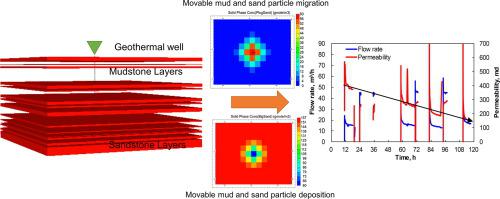Geoscience Frontiers ( IF 8.9 ) Pub Date : 2021-09-16 , DOI: 10.1016/j.gsf.2021.101299 Liang Zhang 1, 2 , Songhe Geng 1 , Linchao Yang 1 , Ronghua Wen 1 , Chuan He 1 , Zhen Zhao 3 , Guangxiong Qin 3

|
The blockage induced by particle migration and deposition is one of the main reasons for the decrease of reinjection capacity in the porous geothermal reservoir with a low and medium temperature. In this paper, a new drilled geothermal well in Xining basin China is taken as an example to investigate the formation blockage risk due to the movable clay and sand particles in pores. The physical properties of the reservoir rocks were analyzed, a series of pumping and reinjection tests were conducted, and the long-term reinjection performance of the well was predicted by numerical simulation based on the test fitting. The results show that the geothermal reservoir rocks are argillaceous and weakly cemented sandstones with a content of movable clay and sand particles up to 0.18–23.42 wt.%. The well presented a high productivity of 935–2186 m3·d−1 at a pressure difference of 0.7–1.62 MPa in the pumping tests associated with a large amount of clay and sand particles produced out, while in the reinjection test, only a low injectivity of 240–480 m3·d−1 was observed at an injection pressure of 0.2–0.6 MPa with the clay and sand particles near the wellbore move into deep. According to the prediction, under conditions of a blockage risk, the injectivity of the well will start to decline after 100 days of injection, and in the third year, it will decrease by 59.00%–77.09%. The influence of invasion of pretreated suspended particles and scale particles can be neglected. Under conditions of a high blockage risk, the injectivity of the well will decrease significantly in the first 20–30 days, with a decline of 75.39%–78.96%. Generally, the higher the injection pressure or rate, the greater the decrease in injectivity of the well caused by particle blockage. Pump lifting is an effective measure to remove the well blockage which can be used regularly.



























 京公网安备 11010802027423号
京公网安备 11010802027423号